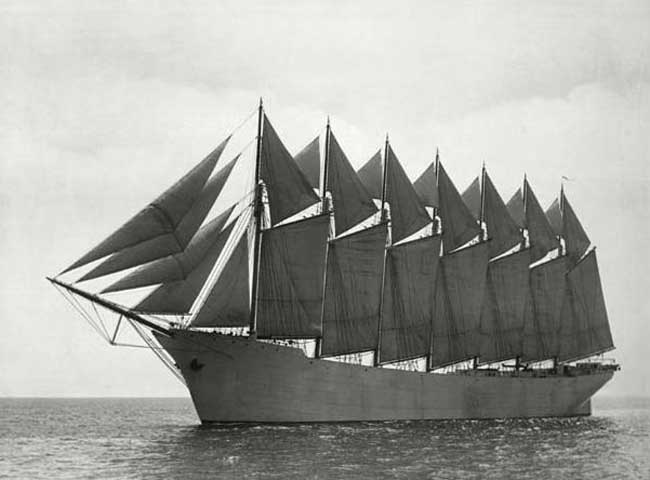We didn't see anything by her on Monday or Tuesday but yesterday she was to be found hanging out at the intersection of physical and financial.
She was looking at one aspect of time in the commodities biz (here's another) dropped a "shedload" on unsuspecting reader and asked the question that's been on everyone's collective mind:
"where the hell has the floating contango trade been?!"However, before we join her here's the first thing that came to mind when I saw her headline, "Floating cash and carry rates, and the GO SLOW tanker phenomenon":

That ridiculous looking thing is the seven masted schooner Thomas W. Lawson, named for a guy Wikipedia describes thusly:
"A highly controversial Boston stock promoter, he is known for both his efforts to promote reforms in the stock markets and the fortune he amassed for himself through highly dubious stock manipulations...."But of course.
Though originally designed as a dry bulk--coal in this case--carrier, after just a few years the Lawson was converted for use as an oil tanker.
And boy was it slow.
As an extra bit of specialness, when it sank in 1907 it created what was probably the world's first large marine oil spill.
That's what I thought of when I saw the headline.
On to FT Alphaville:
Floating cash and carry rates, and the GO SLOW tanker phenomenon
The world is a confusing and tangled web of interconnections. One such set of interconnections relates to the cost and storage of commodities and how it feeds into the wider economy.
For years we’ve made a simple point: the return on commodities is pretty indicative of the natural rate of return. When the return on money beats the return on holding commodity inventories, commodity companies are encouraged to drawdown on inventories in a bid to turn them into higher yielding monetary holdings. All of which has two effects.
In the first instance this encourages a liquidation effect. Commodity prices fall as the market scrambles to swap oil for cash reserves. In the second instance it reduces the amount of buffer commodity stocks in the economy, because holding anything other than emergency reserves is considered a capital cost.
Essentially, when rates rise, it’s symptomatic of a market call for the distribution of previously pent up/stashed up reserves, inventories and commodities.
To the contrary, when the return on money underperforms the return on holding commodity inventories (after storage costs, depreciation, insurance and maintenance are accounted for), commodity companies are encouraged to load up on inventories at a funding expense to themselves in a bid to benefit from the higher returns that can be achieved in commodity markets. All of which also has two effects. In the first instance it encourages a purchasing effect. Commodity prices rise as the market scrambles to swap cash for oil reserves. In the second instance it increases the amount of buffer commodity stocks in the economy, at an overall economic cost to society (because it was drilled up for nothing: idle capital which now has to be maintained, secured and managed for no real reason at all.)
That’s the arbitrage.
Since 2008, commodity markets have mostly benefitted from the latter situation: appalling returns in money markets diminishing the natural costs of storing commodities and hence incentivising storage, especially at times when a guaranteed risk-free return could be had by way of futures market hedges.
But the ability to secure a risk-free hedge in a way which made this trade worthwhile began to be compromised from about 2013 onwards. Significantly, this was about the same time the market began to wake up to the shale over-abundance threat in oil and the scale of the warehouse oversupply problem in metals markets.
It is our proposition that until that point the market had entirely misconstrued the degree to which money dynamics rather than demand were driving commodity prices — whilst driving commodities into dark inventory stashes — and to what degree the futures markets was behind the curve rather than ahead of it....MUCH MORE